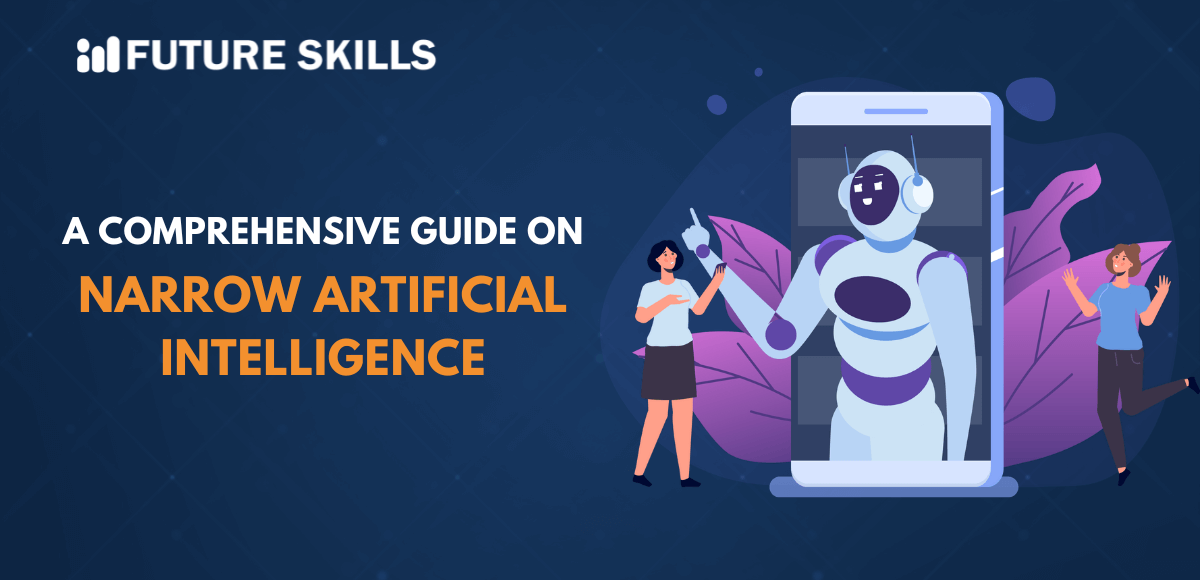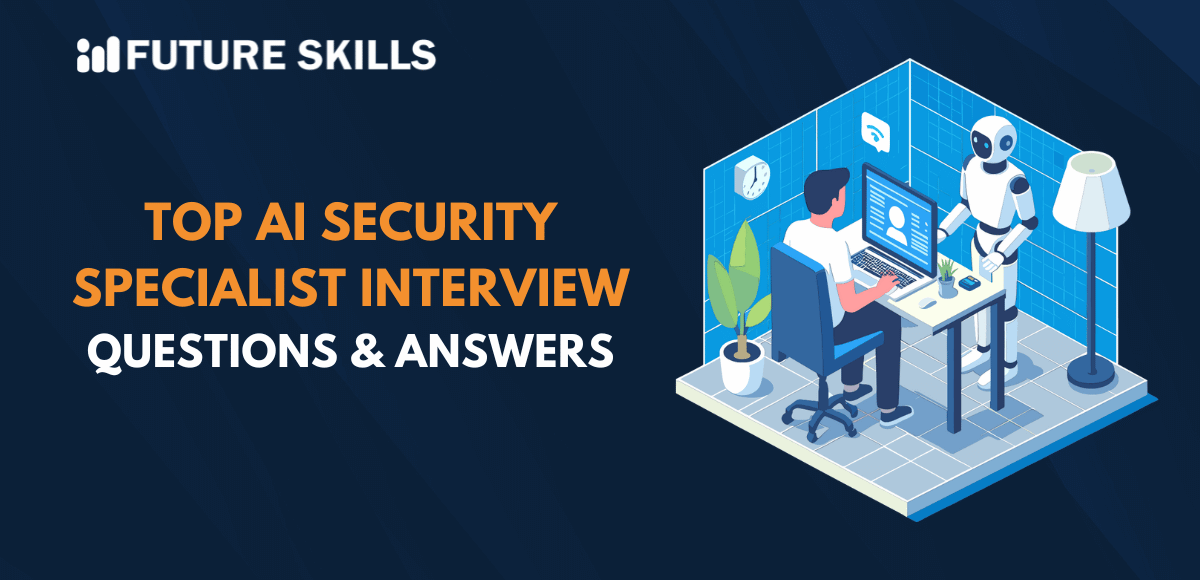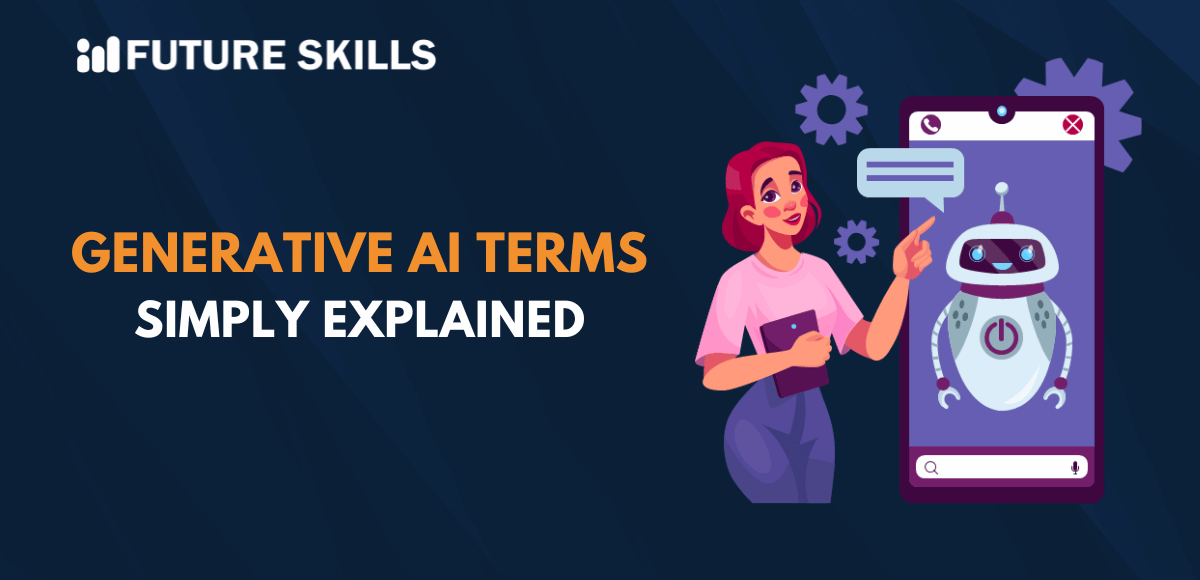Artificial narrow intelligence or narrow AI might seem like a new term to AI enthusiasts and beginners. Surprisingly, narrow AI is the common variant of artificial intelligence you see in different AI-powered applications worldwide. The most notable examples of artificial narrow intelligence or ANI in our world include virtual assistants like Siri. The primary trait of narrow AI systems is the assurance of programming to work on a specific task by drawing information from a particular dataset.
Narrow artificial intelligence can be described as a task-specific variant of AI that focuses on performing better in the concerned task. The applications of narrow AI or ANI systems can range from analysis of raw data to monitoring weather updates. Narrow AI systems don’t have the self-awareness, emotions or consciousness required to work on something beyond the tasks they are designed for. Let us learn more about narrow artificial intelligence and its relevance in the continuously expanding AI ecosystem.
Achieve your career goals with our leading AI Certification Course designed to help you understand the workings of AI in depth. Enroll now!
Discovering the Fundamentals of Narrow Artificial Intelligence
Narrow AI or weak AI has become one of the most popular terms in discussions on the evolution of AI. It represents the existing version of AI that performs specific tasks like natural language processing, image analysis or voice recognition. You may find many narrow artificial intelligence examples in your daily life, such as Google Assistant and Siri. The content recommendation algorithms of Amazon and Netflix are also the most prominent examples of narrow AI.
Narrow AI has been created to perform tasks that would need human intelligence. However, it works within a limited set of constraints to accomplish a single task. Narrow AI cannot develop its own consciousness or understanding of the world around us. The effectiveness of narrow AI systems depends only on the rules programmed in them and the data used for their training.
Many people had assumed that artificial intelligence would be a super intelligent system that would take over our lives and the world. If you take a look at the AI systems being used today, you would find that AI might have a long way to go before it takes over the world. The example of virtual assistants such as Siri proves the same as they cannot develop consciousness or emotions. The AI systems around us are tools programmed to perform specific tasks.
Distinctive Highlights of Narrow Artificial Intelligence
The most striking highlight of narrow artificial intelligence is the ability to work efficiently on a single task. Any narrow artificial intelligence guide would show you the ways in which narrow AI is different from general AI or super AI. General artificial intelligence is an emerging variant of AI that has the capabilities for understanding, learning and applying knowledge across different tasks like humans. On the other hand, narrow AI cannot think beyond the intended scope of its tasks and focuses on the assigned tasks only.
The description of narrow AI may paint it as an inferior version of artificial intelligence that requires improvement. It is also important to note that narrow AI has gained popularity because it can offer better efficiency and accuracy than humans for certain tasks. Narrow artificial intelligence can work round the clock without taking breaks or a salary. The ability of narrow AI systems to process massive amounts of data helps them perform repetitive, dangerous, and time-intensive tasks.
Unraveling the Examples of Narrow AI in the Real World
Narrow AI has been implemented across a wide range of applications in different areas. As a matter of fact, most of the modern AI systems come under the category of narrow artificial intelligence. The review of a narrow AI example list can help you determine the utility of narrow AI in the world. The following examples of narrow AI showcase why it is an integral component of the continuously evolving AI ecosystem.
-
Image Recognition Systems
Social media platforms such as Facebook use weak AI for automatic identification of people in photographs. You must have used this feature to tag people in photos uploaded on Facebook.
-
Voice Assistants
Since the beginning of this discussion, you have noticed that voice assistants such as Siri and Google Assistant are notable examples of narrow AI. Voice assistants use narrow AI for understanding and responding to voice commands and performing tasks such as answering questions, setting alarms or creating itineraries.
-
Weather Forecasting
The review of answers to queries like ‘What is narrow AI?’ shows that narrow AI is the ideal choice for tasks that involve large amounts of data. Weather forecasting is one of the most prominent examples of narrow AI applications that involves large sets of climate data. Weather forecasting systems can use narrow AI to analyze climate data and draw predictions about temperature and other weather conditions.
-
Recommendation Engines
The recommendation engines on content streaming platforms such as Spotify, Netflix and Amazon also serve as popular examples of narrow AI. Recommendation engines use narrow AI for analysis of user behavior and preferences to come up with the best recommendations for customers.
-
Predictive Maintenance Models
Predictive maintenance models also serve as another promising example of narrow AI systems. The models align with the narrow artificial intelligence definition by using data collected from sensors on machines to predict maintenance schedules. Predictive maintenance models can use narrow AI systems efficiently to predict potential failures and ensure proactive alerts for users.
-
Email Filtering
One of the simplest examples of narrow artificial intelligence applications is email filtering. You must have noticed how email service providers like Gmail can detect spam emails and classify the incoming emails into different categories. The magic of narrow AI ensures accurate filtering of emails and improves the user experience.
Advantages of Narrow Artificial Intelligence
The term ‘narrow AI’ may seem limited in terms of capabilities from the initial description. It is also important to remember that narrow AI offers a broad range of advantages as you can notice in the different examples. You can pick any narrow artificial intelligence guide and find some of the most prominent advantages of narrow AI. The benefits of narrow AI help the systems stand out as the best version of AI that we can use to our advantage.
Narrow AI systems have the capability to perform tasks with better efficiency and accuracy than humans. The capabilities of narrow AI also help in reducing the time and effort required for completing certain tasks. You can also rely on the abilities of narrow AI for automation to reduce the possibilities for human error in different tasks.
Another noticeable benefit of narrow AI is the assurance of better availability. Narrow AI systems can work continuously without breaks and you can scale them up or down, according to your needs. The utility of narrow AI systems in certain industries can make the most of the assurance of safety improvements. Narrow AI can take over the repetitive or dangerous tasks that can pose risks to human workers.
Enroll in our new Certified ChatGPT Professional (CCGP)™ program and expand your ChatGPT skills from basics to an advanced level.
Uncovering the Limitations of Narrow Artificial Intelligence
Narrow artificial intelligence might seem like the best version of AI for the world right now. You can use it to perform specific tasks more efficiently and accurately without human intervention. Narrow AI systems will always be under the control of users as they cannot develop consciousness or emotions.
The benefits of artificial narrow intelligence systems could not overshadow the limitations that come with them. Take a look at the following limitations of narrow AI that you must consider while using narrow artificial intelligence.
-
Limited Flexibility
Narrow AI systems have been tailored to work on specific tasks and cannot work on tasks outside the specific domain. You can notice how speech recognition systems experience troubles in understanding certain dialects or accents. For instance, a speech recognition system tailored for British English might face struggles in transcription of American accents.
-
Depending Too Much on Data
The effectiveness of narrow artificial intelligence systems depends on the quantity and quality of data used in their training process. Lack of certain data points in the training datasets can restrict the capabilities of narrow AI systems to process the concerned data. For example, a facial recognition system may fail to recognize faces of people from certain ethnicities. The excessive dependence of narrow AI systems on data also creates concerns about introduction of bias or inaccuracies in their results.
Final Thoughts
The comprehensive introduction to narrow AI reveals that it represents the modern AI systems we use in daily life. Virtual assistants, recommendation engines and facial recognition systems are some of the examples of narrow AI around us. You can notice that the narrow artificial intelligence guide also focuses on their inability to learn new things beyond their scope. You can program narrow AI according to your needs and they would serve better accuracy and efficiency for certain tasks.
The benefits of narrow AI systems may make you believe that they are the best variants of artificial intelligence. On the contrary, you must pay attention to different limitations while using narrow AI. Find more insights on narrow AI and how narrow AI is different from general AI and super AI right now.







